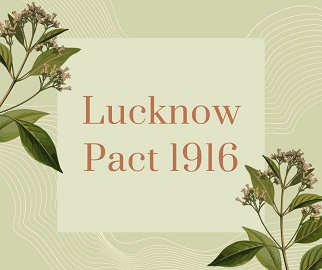Table of Contents
Lucknow Pact 1916:
| The Lucknow session of the INC in 1916 was a memorable event on account of two important developments. The first was the readmission of the Extremists, who had been expelled from the INC. The second development was the bond of alliance between the Congress and the Muslim League. |
Circumstances Leading to the Lucknow Pact 1916:
| International Events– Events taking place outside India drew the league closer to the Congress. Some of these events included- (I) The British occupation of Egypt. (II) The Anglo-Russian Convention of 1907, which divided Persia into two spheres of influence between England and Russia. (III) The hostility of the British government towards the Sultan of Turkey during the Tripoli and Balkan wars in 1911, 1912 and 1913. They looked upon the Sultan as the Caliph of Islam and did not like that he should have been humbled by Italy and the Balkan Powers through the connivance of England. The participation of Turkey in the Great War on the side of Germany convinced the Indian Muslim that the British were not the real friend of Islam. National Events- With the annulment of the Partition of Bengal in 1911, the Muslims felt that they had been cheated. Further, in 1915 the Ali brothers, Muhammad Ali and Shaukat Ali were arrested for supporting Turkey’s entry into the war against the British. Muhammad Ali Jinnah, at the time, a staunch Congress leader and a nationalist, wanted the League to come closer to the Congress. He was instrumental in spreading nationalist ideas. The changed objectives of the League- With the change in the political attitude of the members of the League, there grew a desire for unity with the Congress. At the annual session of the Muslim League held in Lucknow in 1913, the Congress ideal of self-government was adopted. This commonality of interests brought a positive aspect to the relationship between Congress and the League. The Indian National Congress welcomed this change. Efforts to bring both parties Together- It was generally felt among the middle-class Muslims the need to join hands with the Congress in their fight against the British government. Jinnah tried to bring the League and the Congress closer. With this aim, he even organized the League’s annual session at Bombay, at the same time and at the same place as that of the Congress. Even the Congress leaders encouraged the League’s attempt to bridge the gap. Gandhi and Sarojini Naidu attended the League’s session at Bombay. Committees were appointed by both parties to prepare a draft for reforms that were to be demanded from the British government. |
Terms of the Lucknow Pact 1916:
| The main features of the Lucknow Pact 1916 were as follows- (I) The Lucknow Pact exhorted the British Government to confer self-government on India at an early date, to expand the Provincial Legislative Councils and the Governor-General’s Legislative Council and to provide for greater representation of the elected members on the expanded Councils. (II) It further demanded that the powers of making appointments to the Indian Civil Service should vest in the Government of India and that the commissioned and non-commissioned ranks in the military and naval services should be thrown open to Indians. (III) Congress accepted the provision of a Separate Electorate for Muslims, given through the Indian Council Act of 1909 which was a positive gain for the Muslims, because the Congress has so far opposed it. |
Significance/Impact of the Lucknow Pact 1916:
| Positive Impact: (I) The Lucknow Pact was hailed as a great achievement. It symbolized Hindu-Muslim unity at some cost to both parties. The Congress compromised its secular character by accepting the scheme of a Muslim electorate; the league accepted the principles of election and majority rule. (II) The unity between the Congress and the League created a new sense of enthusiasm among the people of India. Even the British Government decided to appease the nationalists by declaring the intention of giving Indian the right to self-govern, as contained in the August Declaration. (III) The Lucknow session of the Congress is notable because at this session the Radicals and the Moderates Congressmen were reconciled. Tilak became secure in his position as the most popular politician in the country. The Home Rule Movement led by Tilak and Annie Besant gave a new impetus to the National Movement. Negative Impact: (I) The Congress failed to retain its secular character by agreeing to a scheme of the communal electorate. (II) Many historians regard the acceptance of the separate electorate by Congress as the birth of the two-nation theory. (III) The compromise demanded more sacrifice on the part of the Hindus. This marked the beginning of the appeasement of Muslims by Congress. (IV) It opened the way to a future resurgence of communalism in Indian politics. |









Comments (No)